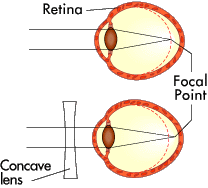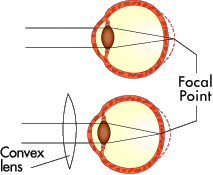Before we talk about refractive vision problems, let's look at how your eye works. In its simplest sense, your eye is like a camera. Your eye has a variable opening called the pupil; a lens system, which includes the transparent covering called the cornea and a spherical lens; a reusable "film" called the retina, and various sets of muscles; the muscles control the size of the opening, the shape of the lens system and the movements of the eye. As shown in Figure 1 , light passes through the cornea and pupil, is bent or refracted (see How Light Works) by the lens, and comes to a point or focus on the retina, where the image is formed.
In the retina, sensory cells called rods and cones change the photons of light into electrical signals, which are then transmitted to and interpreted by the brain. The ability to focus the light on the retina depends on the shapes of the cornea and the lens, which are controlled by their inherent shapes, their stretchiness or elasticity, the shape of the eyeball and sets of attached muscles. So, when you look at something, muscles attached to the lens must contract and relax to change the shape of the lens system and keep the object focused on the retina, even when your eyes move; this is a complex set of muscle movements that is controlled automatically by your nervous system.
Advertisement
Common Problems

Here are the four common refractive vision problems:
- Nearsightedness (myopia)
- Farsightedness (hyperopia)
- Astigmatism
- Presbyopia
In nearsightedness (myopia), the light from distant objects gets focused in front of the retina rather than on it. Myopia happens usually when the eyeball is too long; however, it is sometimes caused by too much focusing power in the lens system. See Figure 2. The result is that the person can see close-up objects fine, but distant objects are blurry. Myopia can be corrected by using a concave lens to diverge, or spread out, the light so that when it passes through the lens system, it comes to focus on the retina.
In farsightedness (hyperopia), the light gets focused in back of the retina rather than on it. See Figure 3. Hyperopia usually happens when the eyeball is too short or when the focusing power of the lens system is too weak. The result is that a person can see distant objects fine, but close-up objects are blurry. Hyperopia can by corrected by using a convex lens to concentrate or converge the light (Figure 3) so that when it passes through the lens system, it comes to focus on the retina.

In astigmatism, the shape of the cornea or the lens is distorted so that the light comes into two focal points. Imagine that the lens is egg-shaped instead of spherical and that light coming over the top and bottom edges is brought to a different focal point than light coming over the right and left sides. To correct this problem, a lens that is shaped to correct the distorted shape of the eye's lens system is made.
In presbyopia, the cornea and lens of the eye become less stretchy and, therefore, they cannot change shape as readily to bring light to a focus on the retina; this happens naturally as we grow older and is usually observed when a person reaches their 40s. If you have presbyopia, you have trouble focusing light from both near and far objects on the retina. To correct this problem, you might get a pair of bifocal lenses, with the top part for seeing far objects and the bottom part for near objects.
To find out how lenses are made to correct these problems, see How Corrective Lenses Work.
Advertisement
